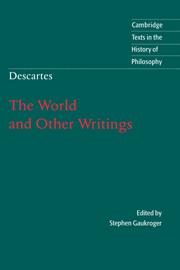Book contents
- Frontmatter
- Contents
- Acknowledgements
- Introduction
- Chronology
- Further reading
- Note on the texts
- The World and Other Writings
- The Treatise on Light
- Discourse 2 of the Dioptrics
- Discourse 8 of the Meteors
- The Treatise on Man
- Description of the Human Body
- Index
- Cambridge texts in the history of philosophy
Discourse 2 of the Dioptrics
Published online by Cambridge University Press: 17 December 2009
- Frontmatter
- Contents
- Acknowledgements
- Introduction
- Chronology
- Further reading
- Note on the texts
- The World and Other Writings
- The Treatise on Light
- Discourse 2 of the Dioptrics
- Discourse 8 of the Meteors
- The Treatise on Man
- Description of the Human Body
- Index
- Cambridge texts in the history of philosophy
Summary
Later on we shall need to know how to determine this refraction quantitatively, and since the comparison I have just used [between the refraction of light and the penetration of a cloth by a tennis ball] enables this to be understood easily, I believe it is appropriate that I explain it here and now, and so as to make it easier to understand, I shall speak first about reflection. Suppose a ball [fig. 19] is struck from A toward B, and at point B meets the surface of the ground CBE, which prevents it from going further and causes it to be deflected: let us see in what direction it will go. But so that we do not get caught up in new difficulties, assume that the ground is perfectly flat and hard, and that the ball always travels at a constant speed, both when it descends and rebounds upwards, and let us ignore entirely the question of the power that continues to move it when it is no longer in contact with the racquet, as well as any effect of its weight, bulk, or shape. For we are not concerned here to examine it closely, and none of these things has a bearing on the action of light, which is what should concern us. We need only note that the power, whatever it be, which can make the motion of this ball continue, is different from that which determines it to move in one direction rather than another.
Information
- Type
- Chapter
- Information
- Descartes: The World and Other Writings , pp. 76 - 84Publisher: Cambridge University PressPrint publication year: 1998
